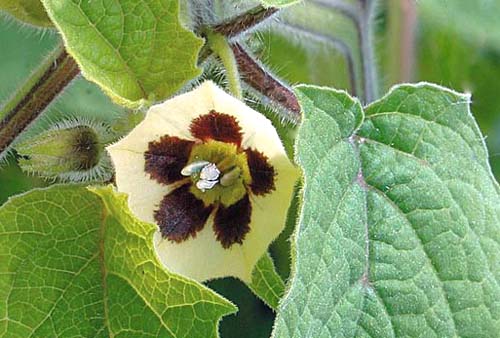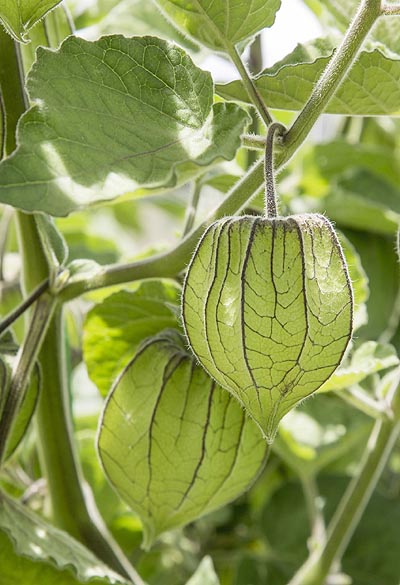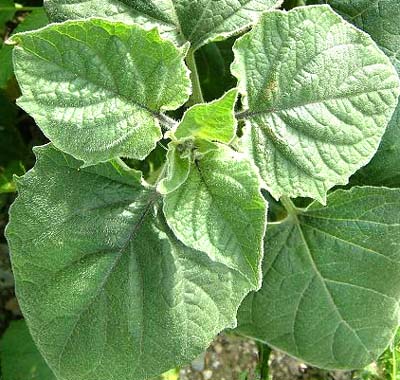If you love fruit then you have to grow this! It's a very easy plant to grow, needs very little care once its established, just plenty of room, sunshine and water. Give it a long growing season and you will be rewarded with delicious sweet but tart golden berries each wrapped in its own brown husk (which is not edible). Cape Gooseberries are very expensive to buy in the stores because they are time consuming to pick but for the home gardener who just wants enough for the family its an ideal plant to grow. The berries are like nothing else and are high in vitamin A, vitamin C and some of the B complex . Grow as an annual in zones 7 and colder, will not survive below 30°F ( °C) and is quickly killed by frost. In warm zones it will live for several years.
Description of Cape Gooseberry (Physalis peruviana).
A spreading soft stemmed bush that grows as a perennial in zones 8 and warmer
and is grown as an annual in colder zones (7 and above). Can grow to 6 feet
( cm) during one season but 2-3 feet ( cm)is more common and has a very sprawling
habit. The stems are stiff, fleshy and brittle they easily break from the plant
or snap if stressed. Stems branch readily and tend to sprawl outwards and down,
stems are ribbed, often have a purplish tinge and are covered with fine hairs.
The leaves are arranged almost opposite and are mid green heart shaped with
pointed end, randomly toothed edges. They can reach 2 3/8 to 6 in (6-15 cm)
long and 1 1/2 to 4 in (4-10 cm) wide and have a very velvety texture. Flowers
are borne solitarily in the leaf axis, these are bell shaped up to 3/4 in (2
cm) wide, yellow in color with 5 dark purple-brown spots in the throat, and
cupped by a purplish-green, hairy, 5-pointed calyx. After the flower falls the
calyx expands to form a initially green globulus husk that is often much larger
than the fruit inside. As it matures the calyx turns brown or straw colored
and often falls from the plant. The fleshy berry inside is globular usually
1/2 to 3/4 in (1.25-2 cm) wide, glossy and orange in color. It contains yellow
pulp with numerous small seeds. When ripe the fruit is sweet with a interesting
tang, the husk is inedible. Large green fruits whose husks have begun to turn
brown will continue to mature even if removed from the bush.
Growing Cape Gooseberry (Physalis peruviana) from Seed.
Cape gooseberries are very easy to grow from seed but take a little longer to
germinate than many other plants. At around 70 -74° F ( 21 -23° C) they
usually germinate in around 14 - 20 days. See our general
growing instructions for more detailed instructions on seeding.
We recommend starting seeds in pots inside at least 6 weeks before the last
frost date, earlier if you can. While cape gooseberries grow quickly the plants
need a long period before they bear fruit so the longest growing season you
can give them the better your crop will be. For this reason we do not recommend
direct sowing of this seed above zone 8 and insufficient time for good plant
development is not always available.
We suggest using small pots or cell pack seed trays for these plants as once
they germinate they tend to grow quite quickly and will easily overshadow other
seedlings in the area.
Transplant to individual pots when the seedlings reach the 2-4 leaf stage using
a good seeding mix with lots of organic material. When danger of frost has passed
harden off outside slowly until acclimatized before planting out.
Cape gooseberries are very easy to grow and grow quickly if given the right
conditions.
Location and Care of Cape Gooseberry (Physalis peruviana).
Cape Gooseberries need full sun in a fairly sheltered position as high winds
can blow the plants over and break the branches. Likes heat and will set more
fruit in higher temperatures. In zones 7b and warmer almost any sunny spot is
good. In zones 7a and higher ensure that it is well sheltered, and as much of
a 'sun trap' as possible. Bushes will set more fruit at higher temperatures
and stop setting fruit when overnight lows begin to dip below 70°F ( 21°
C). Does well against a south facing wall, fence or other windbreak.
Cape Gooseberries tend to sprawl so allow plenty of room each side of your bushes
as you will need to move around them to pick the berries. We like to leave 4
feet between rows as branches can spread significantly and we found 3 feet was
insufficient.
Soil. Needs a well drained soil will not do well in soils that are too
wet
and cannot tolerate anything that gets waterlogged for even short periods
of time. The best soil type is sandy loam but adding organic material to any
soil to ensure it drains well will give reasonable results.
Water. Needs plenty of water. Daily watering in most climates is essential.
We suggest using a soaker hose along the base of the plants run for at least
30 minutes every day, more if the weather is hot and the soil is drying out.
Keeping the soaker hose close to the ground and away from the foliage and the
leaves ensure that all the water reaches the roots of the plant and does not
affect the fruits or leaves making them more susceptible to fungal problems.
Ensure that the soil drains well and the water does not stay pooled around the
plants. Plants will go dormant during drought conditions if not watered.
Feeding is unnecessary. Cape Gooseberries seem to prefer poorer soils and if fed tend to produce far more lush foliage and less fruits. If leaves begin to look yellow or sick than a dilute fertilizer can be applied otherwise they seem to do fine without it. Higher yields are mostly produced on poor soil.
Frost Protection. To extend your berry harvest into the fall months
some protection from early light frosts is recommended. Using row covering fabric
or even an old sheet is usually sufficient. However you need to ensure that
the whole plant is enclosed under the fabric of the leaves will wilt down and
plants will die. Given good frost protection plant life can often be extended
by at least a month of berry harvesting. During this period no new fruits will
set but the a high proportion of the unripe ones on the bushes will mature enough
to be picked and used.
We place all our plants under heavy floating row cover fabric just before the
first frost and leave them covered until the killing frosts take them down.
Ensure all useable berries are picked before the killing frost.
Correct time to plant out. Can depend on your location and pests in your area. See Major pest below and determine what is the best planting time for you.
Growing indoors. We don't recommend this. Since Cape Gooseberries are self fertile they should in theory be as easy to grow in side a greenhouse or other covered structure where insects are excluded. We tried this two different years growing them in hoop houses with wide screened doors on each end to allow good airflow. We got large sprawling plants which did not flower as much and NEVER set fruit. The first year they did get a massive thrips infestation so we tried again using thrips screening. This kept the bugs out but once again we set no fruit and the plants tend to be weaker and sprawl on the ground more. For the most part planting out at the right time to avoid the beetles has proved the best option for this crop.
Pest and Diseases of Cape Gooseberry (Physalis peruviana).
Cape gooseberries can become inflicted with many different pests and diseases
the most common are fungal diseases of the foliage including powdery mildew.
This usually occurs in areas of very high rainfall and humidity and with plants
that are watered from overhead rather than at ground level with a soaker hose.
Using a soaker hose and ensuring that there is good airflow around the plant
are good preventative measure for this problem. We have never had fungal problems
growing Cape Gooseberries.
the major one if
Insects. There are several insects that will attack Cape Gooseberries
these include cut worm, stem borer (Heliotis suflixa), leaf borer (Epiatrix
spp.), fruit moth (Phthorimaea), Colorado potato beetle (Leptinotarsa
decemlineata), flea beetle and striped cucumber beetle (Acalymma vittata).
Major Pest. For us we find that Colorado potato beetle (Leptinotarsa decemlineata), is the major pest of Cape Gooseberries. The larva of this beetle will eat the bushes down to the ground in a few days if left unchecked. We have lost whole crops to this voracious beetle. Since we are an non chemical farm our only recourse was to hand pick all the bugs off the plants. However there is a better method but it takes a bit more planning. You need to delay planting the Cape Gooseberries in the fields until AFTER the beetles have gone through their major egg laying cycle. We tend to keep our plants back in larger pots that hang out on our patio until we see that the beetles have laid their eggs and the larva are developing well. We do this by using native ground cherry plants which in our case is the Smooth groundcherry or longleafed groundcherry (Physalis subglabrata). We usually have several of these growing as 'weeds' somewhere on the farm. Instead of removing them we leave them as indicator plants. Its not long before the Colorado beetles move in, lay their eggs and eat these plants down. We then wait several more weeks before planting out our Cape gooseberries to ensure that the major egg laying is over. In most cases we then have pest free plants for the rest of the season. In most cases we don't plant out all our plants at once because if we get it wrong the plants have been eaten down to nothing before we notice the pest is there.
Harvesting Cape Gooseberry (Physalis peruviana).
Harvesting can be time consuming because the plants tend to sprawl so and its
difficult to get in amongst the branches and find the ripe fruits. Many sources
say that once the fruit is ripe it will fall from the bush and can be collected
then. While this is true not all ripe fruits fall quickly, some tend to hang
on. Also once the fruit is on the ground its lying on moist soil and can begin
to rot faster if not found immediately. Plus once on the ground its easy prey
for slugs, rodents and other animals that also like berries.
For this reason we suggest that you search the plants for fruits whose husks
have turned brown and look at picking those. Some will contain berries that
have not fully ripened yet but most will be ripe. Those that are not can be
placed on a countertop and ripened in the house. Keep the husks closed if possible
to discourage fruit flies.
The major problem with Cape gooseberries is that they don't ripen consistently. Although the flowers may start at the base of the stem and flower progressively outwards they don't always ripen in the same order so some berries that were formed earlier may not ripen until after berries that were formed much later on.
This inconsistency makes means that the picker has to search the whole bush every time rather than just certain portions and it can be time consuming and awkward moving amongst the sprawling branches. However the rewards for this wonderful fruit are so worth it!
Culinary Uses of Cape Gooseberry (Physalis peruviana).
The fruit can be eaten right out of the hand, straight off the bush (they always
seem to taste best that way). They have a wonderfully unique tart flavor eaten
alone of in mixed fruits. They can also be added to salads. Some people like
to dip them in chocolate or roll them in sugar. They make awesome fruit smoothies!
They can also be cooked and make into fruit desserts, preserves and jams and
can be used as dessert toppings. They can also be dried, commercially the dried
fruits are marketed as 'goldenberries'.
The fruit is rich in vitamin A, vitamin C and some of the B complex (thiamine,
niacin and B12). It also has exceptionally high protein and phosphorus levels.
Only the ripe fruit is edible, some people find the green fruits toxic and the
leaves and flowers are poisonous.
Medical uses of Cape Gooseberry (Physalis peruviana).
The leaf juice has been used in the treatment of worms and bowel complaints.
Origins of Cape Gooseberry (Physalis peruviana) plant and its name.
Cape Gooseberries are a native of Brazil but long ago became naturalized in
the highlands of Chile and Peru hence the name Inca berry. Such a delectable
fruit was of course taken to Europe by the conquistadors and soon it was cultivated
there. Later it was taken to South Africa and cultivated there at the cape,
hence the name Cape Gooseberry. In its native range it will grows between 2500
and 10,000 ft (762 - 3048 m). In Hawaii its found between 1,000 and 8,000 feet
(304 -2438 m).
Cape Gooseberry is not a gooseberry at all. Its not even in the gooseberry family,
its in the tomato family a close relative of the ground cherry or husk tomato.
Along with those plants the leaves, stems and flowers are poisonous. It is also
susceptible to the same pests and diseases as many potato and tomato crops especially
the Colorado potato beetle, which will attack this and leave the potatoes alone.
Other names.
Physalis, Ground-cherry, Golden berry, Uchuva, Inca berry, Uvilla, Peruvian
goldenberry, Husk cherry, Peruvian ground cherry, Poha, Poha berry, Aztec berry,
Horse tomato, Physalis peruviana
Synonym Physalis edulis
Misspellings: Cape Goose Berry









